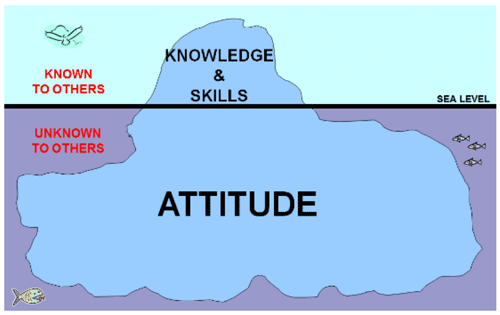Introduction
Bloom's Taxonomy, as you may already have read in the Cell on the cognitive domain, is one of the most extensively used (and maybe misused) works in all of education1. Bloom’s taxonomy in any domain, cognitive or affective or psychomotor, can serve many purposes: it can (1) provide a common language among educators; (2) help determine the alignment of objectives, learning activities, and assessment (even in the affective domain); and (3) stretch the educational possibilities, especially in the affective domain, to give greater vision and imagination to courses and curricula2. Use of Bloom’s taxonomy may even encourage learning at a deeper rather than a more surface level. (See the Cell: Surface and Deep Learning.)
Learning Objectives (what you can reasonably expect to learn in the next 15 minutes):
- Explain the importance of including learning objectives in the affective domain.
- Describe some promising approaches to teaching in the affective domain.
- Classify examples of objectives into aspects of Bloom’s Taxonomy (in the affective domain): Receiving, Responding, Valuing, Commitment, Organization, Characterization.
To what extent are you now able to meet the above objectives? Please record your self-assessments. (0 is not at all and 5 is completely)
Bloom's Taxonomy


Objectives in any domain describe what learners are expected to do (new or differently) as a result of instruction. Objectives in the affective domain involve learning powerful dispositions, preferences, values and feelings. While challenging, it is important that educators attend not only to cognitive and psychomotor learning (education and training) but also to the affective learning (formation) of their students.
Before we launch into an explanation of the affective domain, please describe a teacher or learning situation that taught you beyond what you can do and think, who taught you values and matters of the heart.
Describe that here:
From interest to Attitudes and Values
Many medical educators have argued for direct and explicit support to help medical students, residents, and physicians to internalize the value systems of the medical profession1, 2. Such an emphasis on the affective is also emerging in other professions3. They are promoting a greater emphasis on formation, and specifically professional identify formation1. They are advocating for systematically attending to the affective domain of Bloom’s taxonomy.
Others have argued for instructors to focus more on attitudes in their assessment practices2, in the classroom4, and in the community5. While this Cell does not focus on the details of how to teach to the affective domain or how exactly to help form students, we will however explore in broad terms the general direction in which we as teachers and educators should be moving in organizing appropriate educational activities and programs.
Internalization is central to our understanding of how to teach to the affective domain. Internalization is the acceptance of a set of norms (what we do) and values (why we do it). Simply put, an idea, concept, or value moves from outside and external to a person to inside a person. Internalization is a major element of identity, a sense of how a person sees him or herself6.
Lev Vygotsky proposed that internalization is the outcome of a long series of developmental events that begins with external activity. At first values are “out there,” then they come to live within a person. The individual who starts to internalize reconstructs the external activity; interpersonal activity becomes intrapersonal activity6. To facilitate this formation (or transformation) and the achievement of affective learning objectives, educators may rely on some fairly common, recommended approaches.
Before we move on, what do you anticipate some of these teaching and learning strategies to be?
Check your list against this one: experiential learning (such as service learning – even for those who might not be very interested at first), listening to patient narratives and stories, finding good role models, involving students emotionally, drama and theatre including movies and movie clips5,7-9, and the rigorous, summative assessment of these objectives2 (because if we don’t assess them then we really don’t value them, do we?). How exactly to organize and assess these activities is not an objective of this Cell. Knowing that we should consider them and assess in the affective domain and why, is. Still, learners need to know what the values and attitudes are, why they are important, and the implications for their behaviour. There is always a cognitive element to formation but just knowing is not sufficient.
As the core principles and processes of internalization inform us, all of these activities must be accompanied by dialogue and reflection, deep thought and contemplation, and focused interpersonal discussions with peers and mentors. Without the examination of one’s life and thinking about the meaning of the activities, their power is attenuated.
Now, finally, we turn to the different levels and terms used to describe the developmental process of learning to internalize new values and attitudes. These are the specifics of the objectives that we can write in the affective domain. From Lynch at al (2009) we have the following descriptions of the stages in learning the affective domain3.
- Receiving: shows awareness, willingness to listen, controlled attention, notices values, dispositions, and attitudes in life and literature.
- Responding: accepts responsibility and duty to comply
- Valuing: accepts the values and expresses a preference for the values and attitudes
- Commitment: expresses more than a preference for the values; demonstrates a devotion and commitment to the values, attitudes, and dispositions
- Organization: holds and expresses an organization of a system of inter-related values and attitudes
- Characterization: aligns behaviours and values, acts out of one’s values, develops a consistent philosophy of life and adopts a professional identity
This was your brief introduction to the affective domain of Bloom’s taxonomy. It is important to attend to the formation of our learners. Internalization is a developmental process of knowing, thinking about, and processing values, attitudes, and dispositions. Some more active and experiential educational approaches work better than others.
Check for Understanding
Self-Assessment
Please complete the following very short self-assessment on the objectives of this CORAL cell.
To what extent are you NOW able to meet the following objectives? (0 is not at all and 5 is completely)
To what extent WERE you able the day before beginning this CORAL Cell to meet the following objectives? (0 is not at all and 5 is completely)
Thank you for completing this CORAL Cell. We are interesting in improving this and other cells and would like to use your answers (anonymously of course) along with the following descriptive questions as part of our evaluation data.
Thanks again, and come back soon!
The CORAL Cell Team
References
1 Cruess RL, Cruess SR, Boudreau JD, Snell L, Steinert Y. Reframing medical education to support professional identity formation. Academic Medicine. 2014 Nov 1;89(11):1446-51.
2 Cate TJ, De Haes JC. Summative assessment of medical students in the affective domain. Medical Teacher. 2000 Jan 1;22(1):40-3.
3 Lynch DR, Russell JS, Evans JC, Sutterer KG. Beyond the Cognitive: The Affective Domain, Values, and the Achievement of the Vision [Más allá de lo cognitivo: El dominio afectivo, sus valores y el alcance de la visión] Journal of Professional Issues in Engineering Education and Practice. 2009 Jan;135(1):47-56.
4 Pierre E, Oughton J. The Affective Domain: Undiscovered Country. College Quarterly. 2007;10(4):1-7.
5 Batt-Rawden SA, Chisolm MS, Anton B, Flickinger TE. Teaching empathy to medical students: an updated, systematic review. Academic Medicine. 2013 Aug 1;88(8):1171-7.
6 Wikipedia. Internalization. https://en.wikipedia.org/wiki/Internalisation_(sociology). Accessed March 22, 2018.
7 Holden MD, Buck E, Luk J, Ambriz F, Boisaubin EV, Clark MA, Mihalic AP, Sadler JZ, Sapire KJ, Spike JP, Vince A. Professional identity formation: Creating a longitudinal framework through TIME (transformation in medical education). Academic Medicine. 2015 Jun 1;90(6):761-7.
8 Sawatsky AP, Nordhues HC, Merry SP, Bashir MU, Hafferty FW. Transformative Learning and Professional Identity Formation During International Health Electives: A Qualitative Study Using Grounded Theory. Academic medicine: journal of the Association of American Medical Colleges. 2018 Mar.
9 Chan SC, Ngai G, Kwan KP. Mandatory service learning at university: Do less-inclined students learn from it?. Active Learning in Higher Education. 2017 Nov 15: 1469787417742019.
